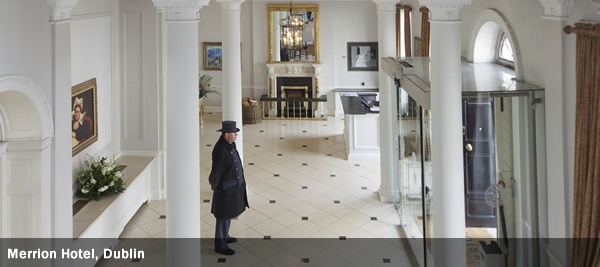Merrion Square is the epitome of Georgian Dublin. Wandering around, it is hard to believe that around 250 years ago the area was farmland on the edge of Dublin city. A far cry from the plush, leafy suburbia that it is today.
As a child, Oscar Wilde lived at No 1 where rumour has it Bram Stoker spent a lot of time visiting Lady Wilde’s salons. The Wilde home was a unique cultural milieu, where Lady Wilde, poet and journalist, hosted an infamous Saturday afternoon salon, reputed to be just as ferocious as her surname. Though many of the Georgian houses that frame the square are distinguished offices; a few are still promoting the vast culture of the city, including the National Gallery and Natural History Museum located at No 4.
W.B. Yeats lived at number 82 and Daniel O’Connell, a great Irish political leader, or ‘the Liberator’ as history fondly prefers to call him, lived at No 58. The British Embassy was once based at no 39 but burned to the ground in the 1970’s following the Bloody Sunday shootings.
Amazingly, The Duke of Wellington, Arthur Wellesley, once described himself as being born in a stable. In actual fact, he was born in a house on Merrion Square that is now the Merrion Hotel. The capital’s most luxurious five star hotel.
Facing Government Buildings, the hotel looks very much like the other discreet period houses, until of course you catch a glimpse of the doorman, dressed in dark grey threads, bowler hat rising for the occasion. At the Front Hall you feel yourself padding cautiously over the marble floor, trusting stiletto heels won’t leave a trace. Plain white walls highlight the original cornices and plasterwork. The fire is roaring, peat logs draught a sweet hue declaring that you have arrived in Ireland.
Art is ever present throughout the hotel. An impressive private collection hangs on practically every wall. Working in oil-on-canvas and panels, Martin Mooney, one of Ireland’s greatest landscape painters, has pride of place in the Front Hall.
Continuing with the Yeats connection, Jack B Yeats, younger brother of W.B. Yeats has what is thought be a self portrait, The Hour of Sleep, also hanging in the Front Hall. It was painted towards the end of his life and solemnly depicts him preparing for his demise.
The Front Hall, this is where the art journey through the hotel really begins.
The Drawing Room continues the sumptuous flow. Chandeliers sparkle, armchairs creak, the fire crackles and the offer of an art inspired afternoon tea created by Paul Kelly, executive pastry chef and judge on The Great Irish Bake Off, is too much to ignore. A word of caution though ladies, the tea pots are made of pure steel, exceptionally heavy; best find a gentleman to assist…
Further culinary delights can be uncovered on your journey through the hotel. The Cellar Bar, actually built in the wine vaults of the Main House, offers a gastro pub menu and the chance to get to listen to a story or ‘sceal’ in Irish, being recalled by the locals.
Beside the bar, the Cellar Restaurant offers a range of local produce masterly transformed into mouth-watering delights. Options include veal Carpaccio, Ballinwillin roast loin of Venison and grilled Kilmore Quay black sole. The restaurant is designed in such as way as to make the most of the old vaults. Brick archways, romantic corners and a dim light that subtlety lights the features of your companion’s face are just enough to give it an air of mystery. It won the best Hotel Restaurant, from the Restaurant Association of Ireland in 2014. Enough said.
For those chasing the ultimate culinary experience, venture to Restaurant Patrick Guilbaud, the only restaurant in Ireland to hold the coveted two Michelin stars. Allow yourself to be dazzled not only by the taste but the presentation, which just like the marble floor seems a shame to disturb.
Venturing outside, it’s easy to see why the gardens are perfect for all seasons, although the summer is the only time that you can catch a glimpse of the deep pink Merrion rose. Wrap yourself up warm in winter and gaze wistfully at the pond, huddled around a hot Irish whiskey, or eat al fresco by the lavender sprigs in the summer. The choice is yours.
Boxed hedge rows, and the pond that charms the birds from the trees are a parody to the era. Thankfully certain elements such as the smell of horse manure or the clicking of hooves on the cobbled streets outside are no longer are.
The Tethra Spa, named after Irish mythology, offers a calming experience and a range of treatments. Just the ticket before ascending to your room.
The rooms are inviting, cleverly designed and yet homely all in one go. The clean white theme continues through the coffee tables, side cabinets and linen. The fireplace, although ornamental, is a classic addition. Taupe and creams complement the Irish landscape paintings and the marble clad bathroom is in keeping with the welcoming front hall.
As you leave the hotel and walk along Merrion Square keep your eyes open for little circles of metal about a foot in diameter buried in the ground. Apparently this was where coal used to be poured into the basement of the buildings to generate heat for the gentry. At least today, the Merrion ensures that you are kept warm without all the Georgian hassle, yet it still retains all of it’s’ history and charm.
As W. B. Yeats so eloquently wrote ‘I have spread my dreams under your feet;
Tread softly because you tread on my dreams’. The Merrion does just this, offering luxury as if you are immersed in a wonderful dream. Just tread softly on the marble.
The Merrion, Dublin from €275 per room per night based on two sharing with a full Irish breakfast. www.merrionhotel.com / +353 1 603 0600 / info@merrionhotel.com
